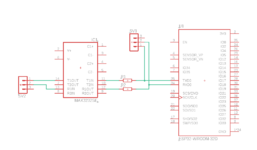htekin42
Member level 2
Hi there,
I am trying to design a pcb with ESP32 and using max3232 for serial communication. My problem is when I connect max3232 directly with max3232, I cannot program ESP32 on TTL pin header. When I made a research I need to add resistor between max3232 and ESP32 to program it on TTL side. I could not find any information about defining resistor value. How can I define resistor value between ESP32 and max3232 to program it without any problem on TTL header.
thanks
I am trying to design a pcb with ESP32 and using max3232 for serial communication. My problem is when I connect max3232 directly with max3232, I cannot program ESP32 on TTL pin header. When I made a research I need to add resistor between max3232 and ESP32 to program it on TTL side. I could not find any information about defining resistor value. How can I define resistor value between ESP32 and max3232 to program it without any problem on TTL header.
thanks
